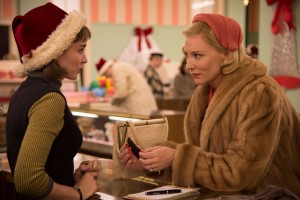Carol
Carol, 2015, 3 ¼ stars
Carol is haunting despite its emotional distance
From The Orlando Weekly, January 13, 2016
“You don’t try to photograph the reality,” Stanley Kubrick once said. “You try and photograph the photograph of reality.”
If that’s true, then Carol, the romantic drama from director Todd Haynes (Far From Heaven), goes one step further by photographing the photo of the photo, and thereby creating a hazy, distant depiction of forbidden love. His Impressionistic approach may seem pretentious, detached and even unemotional. Yet the film’s sensitivity, nuanced performances and social relevance ultimately combine to deliver a haunting, if slightly ponderous, product.
Written by Phyllis Nagy – from the 1952 novel by Patricia Highsmith – and shot in a sumptuous and stylistic manner, the film tackles Eisenhower-era lesbianism. Therese, a timid, 20-something shop girl at a Manhattan department store, meets middle-aged Carol while the latter is searching for an extravagant Christmas gift for her daughter to both reflect her budget and fill the parental void that her pending divorce has created. She chooses a train set, but the “little engine that could” simply can’t work marital magic, and before long it’s Carol who is hitting the rails to find love outside her broken home.
She turns to Therese, who is immediately infatuated with Carol – more than Carol is with her. Indeed, the novel was written almost entirely from Therese’s point of view, perhaps to give the story a sense of longing or to shroud Carol in mystery. Though the film gives the characters equal emphasis, Carol remains a bit of a cipher, and the lack of chemistry between Cate Blanchett (Carol) and Rooney Mara (Therese) doesn’t help us understand the characters or feel their passion.
She chooses a train set, but the “little engine that could” simply can’t work marital magic, and before long it’s Carol who is hitting the rails to find love outside her broken home.
Despite the distance between the leads, their individual performances are stellar. Mara conveys confused beauty while capturing the deer-in-the-headlights look of young love. But, except for one scene, her smoldering desire doesn’t fully catch fire.
The same might be said for Blanchett, who, ironically, seems to shine most brightly not when in the embrace of her young companion but instead in scenes with her neglectful but nevertheless passionate husband, Harge, played well by Kyle Chandler. Blanchett is particularly effective when she’s fighting for both her daughter and her dignity, and if she garners her seventh Oscar nomination, it will be because of those moments. Not so successful are Sarah Paulson (Carol’s closest friend) and Jack Lacy (Therese’s boyfriend). While Paulson’s performance is fine, she has disappointingly little to do. If only the same could be said for Lacy, who doesn’t grasp the finer points of his role.
While the story is thin and contains a small surprise late in the film that stretches believability, the art direction and ambience are effective. Indeed, except for one odd reference to the Interstate Highway System, which wasn’t begun until after the film’s events, the movie successfully conjures up 1950s glamour, style and anti-gay bigotry.
“What a strange girl you are, flung out of space,” Carol tells Therese. Strange, too, is the film, which, despite its emotional inaccessibility and overreliance on aesthetics, is still worth a watch for those with maturity and patience.
© 2016 Orlando Weekly / MeierMovies, LLC
